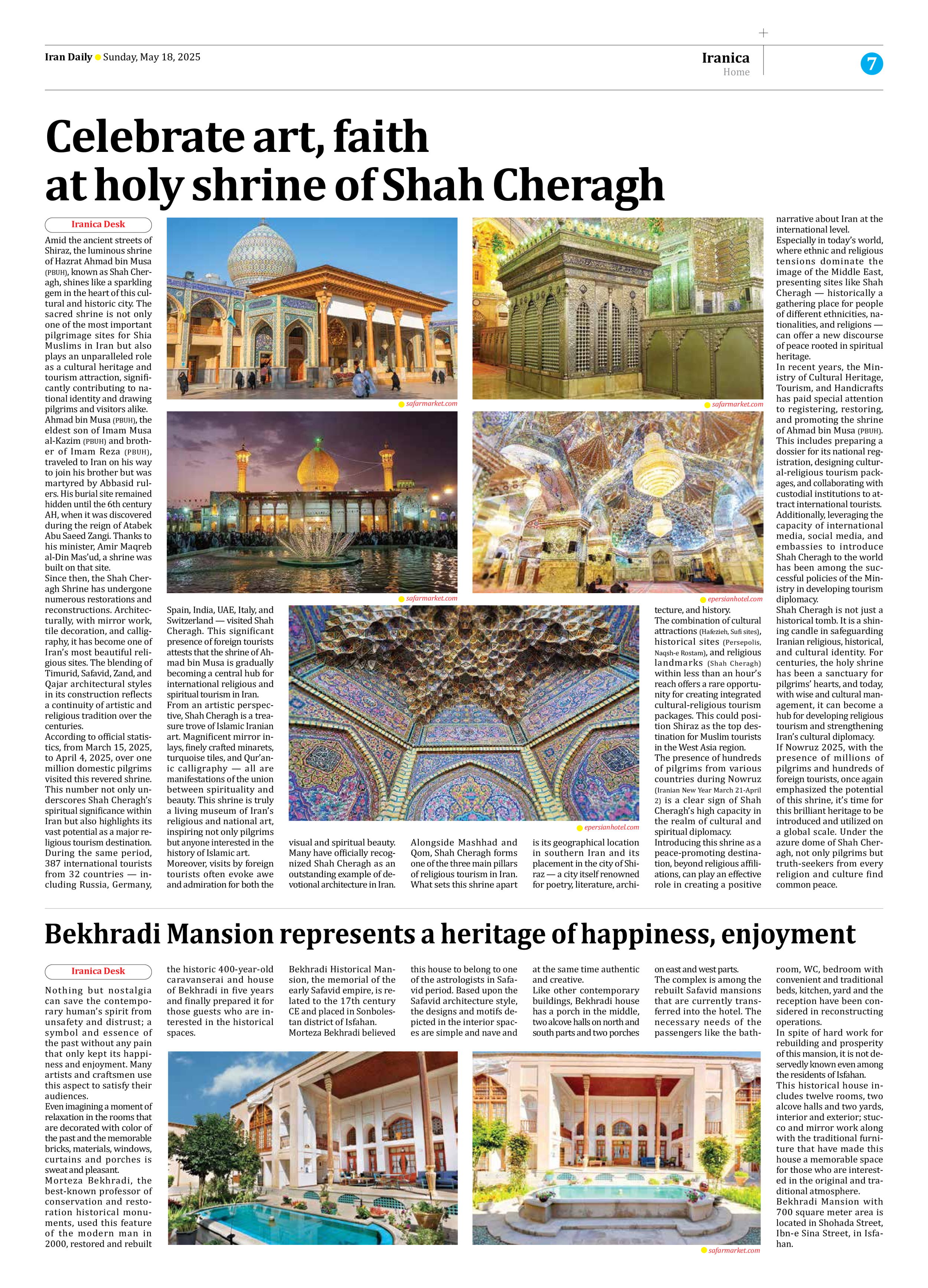
Celebrate art, faith at holy shrine of Shah Cheragh
Amid the ancient streets of Shiraz, the luminous shrine of Hazrat Ahmad bin Musa (PBUH), known as Shah Cheragh, shines like a sparkling gem in the heart of this cultural and historic city. The sacred shrine is not only one of the most important pilgrimage sites for Shia Muslims in Iran but also plays an unparalleled role as a cultural heritage and tourism attraction, significantly contributing to national identity and drawing pilgrims and visitors alike.
Ahmad bin Musa (PBUH), the eldest son of Imam Musa al-Kazim (PBUH) and brother of Imam Reza (PBUH), traveled to Iran on his way to join his brother but was martyred by Abbasid rulers. His burial site remained hidden until the 6th century AH, when it was discovered during the reign of Atabek Abu Saeed Zangi. Thanks to his minister, Amir Maqreb al-Din Mas’ud, a shrine was built on that site.
Since then, the Shah Cheragh Shrine has undergone numerous restorations and reconstructions. Architecturally, with mirror work, tile decoration, and calligraphy, it has become one of Iran’s most beautiful religious sites. The blending of Timurid, Safavid, Zand, and Qajar architectural styles in its construction reflects a continuity of artistic and religious tradition over the centuries.
According to official statistics, from March 15, 2025, to April 4, 2025, over one million domestic pilgrims visited this revered shrine. This number not only underscores Shah Cheragh’s spiritual significance within Iran but also highlights its vast potential as a major religious tourism destination.
During the same period, 387 international tourists from 32 countries — including Russia, Germany, Spain, India, UAE, Italy, and Switzerland — visited Shah Cheragh. This significant presence of foreign tourists attests that the shrine of Ahmad bin Musa is gradually becoming a central hub for international religious and spiritual tourism in Iran.
From an artistic perspective, Shah Cheragh is a treasure trove of Islamic Iranian art. Magnificent mirror inlays, finely crafted minarets, turquoise tiles, and Qur’anic calligraphy — all are manifestations of the union between spirituality and beauty. This shrine is truly a living museum of Iran’s religious and national art, inspiring not only pilgrims but anyone interested in the history of Islamic art.
Moreover, visits by foreign tourists often evoke awe and admiration for both the visual and spiritual beauty. Many have officially recognized Shah Cheragh as an outstanding example of devotional architecture in Iran.
Alongside Mashhad and Qom, Shah Cheragh forms one of the three main pillars of religious tourism in Iran. What sets this shrine apart is its geographical location in southern Iran and its placement in the city of Shiraz — a city itself renowned for poetry, literature, architecture, and history.
The combination of cultural attractions (Hafezieh, Sufi sites), historical sites (Persepolis, Naqsh-e Rostam), and religious landmarks (Shah Cheragh) within less than an hour’s reach offers a rare opportunity for creating integrated cultural-religious tourism packages. This could position Shiraz as the top destination for Muslim tourists in the West Asia region.
The presence of hundreds of pilgrims from various countries during Nowruz (Iranian New Year March 21-April 2) is a clear sign of Shah Cheragh’s high capacity in the realm of cultural and spiritual diplomacy.
Introducing this shrine as a peace-promoting destination, beyond religious affiliations, can play an effective role in creating a positive narrative about Iran at the international level.
Especially in today’s world, where ethnic and religious tensions dominate the image of the Middle East, presenting sites like Shah Cheragh — historically a gathering place for people of different ethnicities, nationalities, and religions — can offer a new discourse of peace rooted in spiritual heritage.
In recent years, the Ministry of Cultural Heritage, Tourism, and Handicrafts has paid special attention to registering, restoring, and promoting the shrine of Ahmad bin Musa (PBUH). This includes preparing a dossier for its national registration, designing cultural-religious tourism packages, and collaborating with custodial institutions to attract international tourists.
Additionally, leveraging the capacity of international media, social media, and embassies to introduce Shah Cheragh to the world has been among the successful policies of the Ministry in developing tourism diplomacy.
Shah Cheragh is not just a historical tomb. It is a shining candle in safeguarding Iranian religious, historical, and cultural identity. For centuries, the holy shrine has been a sanctuary for pilgrims’ hearts, and today, with wise and cultural management, it can become a hub for developing religious tourism and strengthening Iran’s cultural diplomacy.
If Nowruz 2025, with the presence of millions of pilgrims and hundreds of foreign tourists, once again emphasized the potential of this shrine, it’s time for this brilliant heritage to be introduced and utilized on a global scale. Under the azure dome of Shah Cheragh, not only pilgrims but truth-seekers from every religion and culture find common peace.







